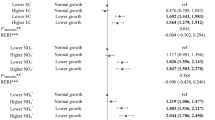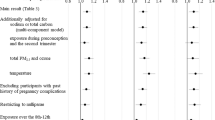Abstract
BACKGROUND
Volatile organic compounds (VOCs) might restrict prenatal and postnatal growth. However, the effect of the exposure of prenatal VOCs on postnatal growth has not been studied sufficiently. Thus, we investigated the relationship between the exposure of total volatile organic compounds (TVOCs) during pregnancy and its effects on postnatal growth.
METHODS
A total of 383 pregnant participants were enrolled from 2006 to 2008. We investigated maternal characteristics using a questionnaire. Personal air samples of TVOCs were obtained in mid or late pregnancy. After these mothers had given birth, 360 singleton newborns were selected and postnatal follow-up data were collected at 6, 12, 24, and 36 months, as well as anthropometric factors including body weight. Multiple general linear and mixed models were applied for statistical analyses.
RESULTS
The mean concentration of prenatal exposure to TVOCs was 284.2 μg/m3 and that of formaldehyde was 81.6 μg/m3. The birth weight of newborns decreased significantly with prenatal TVOC exposure (β=−45.89, P=0.04). The adjusted mean body weight was 300 g lower in the high-TVOC group (⩾75th) compared with that in the low-exposure group (<75th).
CONCLUSION
These results indicate that elevated exposure to TVOCs during the prenatal period may adversely influence early postnatal growth.
Similar content being viewed by others
Log in or create a free account to read this content
Gain free access to this article, as well as selected content from this journal and more on nature.com
or
References
Nethery E, Brauer M, Janssen P . Time-activity patterns of pregnant women and changes during the course of pregnancy. J Expo Sci Environ Epidemiol 2009;19:317.
Stock T, Mendez S . A survey of typical exposures to formaldehyde in Houston area residences. Am Ind Hyg Assoc J 1985;46:313–7.
Hougaard KSØ, Hass U, Lund SØP et al, Effects of prenatal exposure to toluene on postnatal development and behavior in rats. Neurotoxicol Teratol 1999;21:241–50.
Collins JJ, Ness R, Tyl RW et al, A review of adverse pregnancy outcomes and formaldehyde exposure in human and animal studies. Regul Toxicol Pharmacol 2001;34:17–34.
Maroziene L, Grazuleviciene R . Maternal exposure to low-level air pollution and pregnancy outcomes: a population-based study. Environ Health 2002;1:6.
Duong A, Steinmaus C, McHale CM et al, Reproductive and developmental toxicity of formaldehyde: A systematic review. Mutat Res 2011;728:118–38.
Cogliano VJ, Grosse Y, Baan RA et al, Meeting report: summary of IARC monographs on formaldehyde, 2-butoxyethanol, and 1-tert-butoxy-2-propanol. Environ Health Perspect 2005;113:1205–8.
Wilbourn J, Heseltine E, Møller H . IARC evaluates wood dust and formaldehyde. International Agency for Research on Cancer. Scand J Work Environ Health 1995;21:229–32.
Zuurbier M, Lundqvist C, Salines G et al, The environmental health of children: priorities in Europe. Int J Occup Med Environ Health 2007;20:291–308.
Kim B, Ha M, Park H et al, The Mothers and Children's Environmental Health (MOCEH) study. Eur J Epidemiol. 2009;24:573–83.
The Korean pediatric society and Ministry of Health and Welfare. The Development of Growth Standard for Korean Children and Adolescents 2007.
Liang K-Y, Zeger SL . Longitudinal data analysis using generalized linear models. Biometrika 1986;73:13–22.
Twisk JWR . Applied Longitudinal Data Analysis for Epidemiology: a Practical Guide. Cambridge University Press: Cambridge, 2003.
Hwang Y, Lee K, Kim S et al, Measurement of residential volatile organic compound exposure through a participant-based method. J Environm Health Sci 2011;37:369–75.
Guo H, Kwok N, Cheng H et al, Formaldehyde and volatile organic compounds in Hong Kong homes: concentrations and impact factors. Indoor air 2009;19:206–17.
Dingle P, Franklin P . Formaldehyde levels and the factors affecting these levels in homes in Perth, Western Australia. Indoor Built Environ 2002;11:111.
Sakai K, Norbäck D, Mi Y et al, A comparison of indoor air pollutants in Japan and Sweden: formaldehyde, nitrogen dioxide, and chlorinated volatile organic compounds. Environ Res 2004;94:75–85.
Gilbert NL, Gauvin D, Guay M et al, Housing characteristics and indoor concentrations of nitrogen dioxide and formaldehyde in Quebec City, Canada. Environ Res 2006;102:1–8.
Jaddoe VWV, EJWM Troe, Hofman A et al, Active and passive maternal smoking during pregnancy and the risks of low birthweight and preterm birth: the Generation R Study. Paediatr Perinat Epidemiol 2008;22:162–71.
Jhun HJ, Seo HG, Lee DH et al, Self-reported smoking and urinary cotinine levels among pregnant women in Korea and factors associated with smoking during pregnancy. J Korean Med Sci 2010;25:752–757.
Health Canada Environmental and Workplace Health: Formaldehyde. Secondary Environmental and Workplace Health: Formaldehyde. Available at http://www.hc-sc.gc.ca/ewh-semt/air/in/poll/construction/formaldehyde-eng.php (assessed 28 July 2016).
EPA. US An Introduction to Indoor Air Quality (IAQ) Formaldehyde. Secondary An Introduction to Indoor Air Quality (IAQ) Formaldehyde. Available at http://www.epa.gov/iaq/formalde.html (assessed 28 July 2016).
Bluyssen P . The Indoor Environment Handbook: how to make Buildings Healthy and Comfortable. Earthscan James & James: London, UK, 2009.
Chen D, Cho SI, Chen C et al, Exposure to benzene, occupational stress, and reduced birth weight. Occup Environ Med 2000;57:661–7.
Slama R, Thiebaugeorges O, Goua V et al, Maternal personal exposure to airborne benzene and intrauterine growth. Environ Health Perspect 2009;117:1313.
Aguilera I, Garcia-Esteban R, Iñiguez C et al, Prenatal exposure to traffic-related air pollution and ultrasound measures of fetal growth in the INMA Sabadell cohort. Environ Health Perspect 2010;118:705.
Barker D . The developmental origins of adult disease. J Am Coll Nutr 2004;23 (suppl 6): 88S–595S.
Ben-Shlomo Y, Kuh D . A life course approach to chronic disease epidemiology: conceptual models, empirical challenges and interdisciplinary perspectives. Int J Epidemiol 2002;31:285–93.
Landrigan PJ, Trasande L, Thorpe LE et al, The National Children’s Study: a 21-year prospective study of 100 000 American children. Pediatrics 2006;118:2173–86.
Guxens M, Ballester F, Espada M et al, Cohort Profile: The INMA—INfancia y Medio Ambiente—(Environment and Childhood) Project. Int J Epidemiol 2011;41:930–40.
Vrijheid M, Casas M, Bergström A et al, European birth cohorts for environmental health research. Environ Health Perspect 2012;120:29–37.
Moro AM, Brucker N, Charão M et al, Evaluation of genotoxicity and oxidative damage in painters exposed to low levels of toluene. Mutat Res 2012;746:42–8.
Lagorio S, Tagesson C, Forastiere F et al, Exposure to benzene and urinary concentrations of 8-hydroxydeoxyguanosine, a biological marker of oxidative damage to DNA. Occup Environ Med 1994;51:739–43.
Moro AM, Charão M, Brucker N et al, Effects of low-level exposure to xenobiotics present in paints on oxidative stress in workers. Sci Total Environ 2010;408:4461–7.
Karowicz-Bilińska A, Suzin J, Sieroszewski P . Evaluation of oxidative stress indices during treatment in pregnant women with intrauterine growth retardation. Med Sci Monit 2002;8:CR211.
Biri A, Bozkurt N, Turp A et al, Role of oxidative stress in intrauterine growth restriction. Gynecol Obstet Invest 2007;64:187–92.
Kim YJ, Hong YC, Lee KH et al, Oxidative stress in pregnant women and birth weight reduction. Reprod Toxicol 2005;19:487–92.
Baiz N, Slama R, Bene MC et al, Maternal exposure to air pollution before and during pregnancy related to changes in newborn's cord blood lymphocyte subpopulations. The EDEN Study Cohort. BMC Pregnancy Childbirth 2011;11:87.
Hong YC, Lee JT, Kim H et al, Effects of air pollutants on acute stroke mortality. Environ Health Perspect 2002;110:187.
Lehmann I, Thoelke A, Rehwagen M et al, The influence of maternal exposure to volatile organic compounds on the cytokine secretion profile of neonatal T cells. Environ Toxicol 2002;17:203–10.
Acknowledgements
We thank Young-Man Roh for providing expertise in the exposure assessment, and all mothers for permitting researchers to measure their home environmental TVOCs.
Author information
Authors and Affiliations
Corresponding author
Ethics declarations
Competing interests
The authors declare no conflict of interest.
Additional information
Statement of Financial Support
This study was supported by the National Institute of Environmental Research, Korea.
Rights and permissions
About this article
Cite this article
Chang, M., Park, H., Ha, M. et al. The effect of prenatal TVOC exposure on birth and infantile weight: the Mothers and Children’s Environmental Health study. Pediatr Res 82, 423–428 (2017). https://doi.org/10.1038/pr.2017.55
Received:
Accepted:
Published:
Issue date:
DOI: https://doi.org/10.1038/pr.2017.55
This article is cited by
-
Maternal multivitamin supplementation mitigates the risk of fetal congenital heart disease associated with high indoor total volatile organic compounds exposure in east china: a case-control study
Environmental Health (2024)
-
Volatile Organic Compounds Detected in Amniotic Fluid of Women During Normal Pregnancy
Exposure and Health (2024)
-
Geographical approach analysis of the impact of air pollution on newborn intrauterine growth and cord blood DNA damage in Mexico City
Journal of Exposure Science & Environmental Epidemiology (2024)
-
Association between maternal exposure to indoor air pollution and offspring congenital heart disease: a case–control study in East China
BMC Public Health (2022)
-
Migration of cyclohexanone and 3,3,5-trimethylcyclohexanone from a neonatal enteral feeding system into human milk
Journal of Perinatology (2021)



